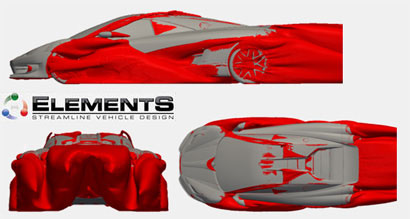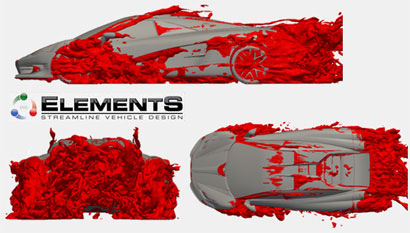"Differences Between Steady State and Transient CFD Simulations"
Computational Fluid Dynamics is a simulation technique for predicting flow around and through objects. It is used extensively in the automotive industry for:
• Aerodynamics (drag and lift prediction)
• Powertrain Cooling
• Cabin Cooling
• Brake Cooling
• Soiling Prediction
• Wind Noise
• Crosswind Stability
Most commercial codes have until recently used a simplified approach called Reynolds Averaged Navier Stokes because of how difficult it is to solve these problems. This produces a steady state flow field that loses a lot of the finer details of the flow.
More recently transient techniques such as Detached Eddy Simulation (DES) have become more common as they better capture the turbulent flows common around cars and trucks. They are more accurate but typically take up to 5-10 times longer to compute.
ELEMENTS Analysis is a new CFD code that only takes twice as long to compute transient simulations. This makes it 3-5 times faster than the competition and gives you maximum accuracy in shorter time. Learn more at the ARC CFD webpage.
The partnership between ARC and ENGYS Ltd provides a unique benefit to the ELEMENTS CFD software suite. ENGYS Ltd is composed of personnel who participated in writing the core of OpenFOAM™ source code and continue advanced software development beyond what is publicly available, while ARC provides the validation tools and design experience to ensure top correlation between CFD and actual real world results.

Computational Fluid Dynamics is a simulation technique for predicting flow around and through objects. It is used extensively in the automotive industry for:
• Aerodynamics (drag and lift prediction)
• Powertrain Cooling
• Cabin Cooling
• Brake Cooling
• Soiling Prediction
• Wind Noise
• Crosswind Stability
Most commercial codes have until recently used a simplified approach called Reynolds Averaged Navier Stokes because of how difficult it is to solve these problems. This produces a steady state flow field that loses a lot of the finer details of the flow.

More recently transient techniques such as Detached Eddy Simulation (DES) have become more common as they better capture the turbulent flows common around cars and trucks. They are more accurate but typically take up to 5-10 times longer to compute.

ELEMENTS Analysis is a new CFD code that only takes twice as long to compute transient simulations. This makes it 3-5 times faster than the competition and gives you maximum accuracy in shorter time. Learn more at the ARC CFD webpage.
The partnership between ARC and ENGYS Ltd provides a unique benefit to the ELEMENTS CFD software suite. ENGYS Ltd is composed of personnel who participated in writing the core of OpenFOAM™ source code and continue advanced software development beyond what is publicly available, while ARC provides the validation tools and design experience to ensure top correlation between CFD and actual real world results.
 |
 |
 |
KEEP UP TO DATE ON CURRENT ARC TECHNOLOGY
Join the ARC Newsletter, the Inside Track with ARC

Motorsports Production Commercial Government
Auto Research Center © 2026. All Rights Reserved. Terms of Use . Privacy
Address: 4012 Championship Drive, Indianapolis, IN 46268
Phone: 317-291-8600 Fax: 317-291-8700 Email: sales@arcindy.com
